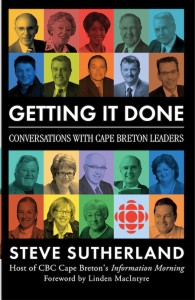In 2009, CBC Information Morning Cape Breton host Steve Sutherland embarked on a mission to interview some prominent local figures on the topic of leadership, and on their own roles as leaders. Getting It Done: Conversations With Cape Breton Leaders is a convenient compilation of these interviews, compiled with some extra material that was edited out for the original radio broadcast versions.
By his own admission, Sutherland does not attempt to fashion any grand insights into leadership, and the lessons he formulates in the book’s brief afterword function more as a tidy wrap-up than anything else. The real value is getting to read the thoughts of people like Lieutenant Governor Mayann Francis’ childhood as a part of the African Orthodox Church in Whitney Pier, Mi’Kmaw elder Murdena Marshall’s reflections on leadership in the First Nations communities, or former Premier Rodney MacDonald fresh from his resignation after the electoral defeat of his party.
Older readers will have a special appreciation for this book, since many of these interviewees are at or near the conclusions of their careers. On the other hand, Getting it Done can also brings some local or obscure history to life for younger readers, though it would be best accompanied by a good study and understanding of recent local history.
For those ordinary Cape Bretoners who don’t get access to certain social networks of local power, Getting it Done provides an interesting who’s who of the local movers and shakers. Many of these characters, particularly those active in the private sector, conduct their work and dealmaking out of the direct limelight. A good example of this is Marty Chernin, who played significant part in shaping the modern character of downtown Sydney. Most people wouldn’t recognize him in person, but they would recognize many of the things he helped build, including 500 George Place, the TD Bank, Commerce Tower, and the building where the Vogue Theatre used to be.
Part of the fun of Getting It Done is in finding connections amongst the interviewees. The late Irving Schwartz is mentioned more than once by his fellow interviewees as someone they look up to as a role model and object of admiration, a touching tribute to the beloved man who passed away just after the book was released. Green Party leader Elizabeth May speaks admiringly of former Progressive Conservative MP Flora MacDonald as an individual who demonstrated exemplary and dignified conduct when faced with the difficulties of navigating the old boys club politics within both her own party and in the House of Commons.
Whatever Sutherland’s process for selecting interviewees, the results are akin to a Premier or Prime Minister selecting cabinet ministers. Merit, racial and cultural diversity, an attempt at gender balance, geographical representation, and crucially for Sutherland’s book, the need to select leaders in a variety of sectors and activities. The result is a decent number of women, one Acadien, two from the First Nations, an African Nova Scotian, a couple of Jewish individuals, and at least one person of Arab descent; but at the end of the day there are still an awful lot of white, English speaking men. This is not a complaint so much as an observation, and it’s likely an appropriate reflection of who gets to have access to the levers of power and platforms of influence.
One glaring omission in this book is the absence of an interview with CBRM John Morgan, whose absence wouldn’t be so strongly felt had Sutherland not mentioned him in the book’s forward. Perhaps he might not have been a good fit for this particular volume since he’s still in the thick of his political career, in which case it would be very appropriate to include him in the current set of interviews with the younger generation of Cape Breton leaders. The fact that he has resolutely pursued his lawsuit against the province, rumpled the feathers of Cape Breton’s elite while doing so, and that he repeatedly receives an overwhelming majority of electoral support is something that makes him most deserving of an interview—and obligates him to grant Mr. Sutherland an audience.
I hope that Morgan was not excluded for political reasons, since Sutherland cheekily hints that, in his interview with retired union organizer Victor Tomiczek, some may disagree with including the “controversial” activist and agitator—as if anyone would be foolish enough to exclude a prominent labour activist on an island that is prominient in Canada’s labour history for its strong, militant activism. To put this in perspective, many Cape Bretoners today can still tell you who Bill Davis is (and what Davis Day is about), but few people can recall who the president of the British Empire Steel Corporation was at the time of Davis’ death on the picket line in 1925.
Overall, Sutherland’s book is well worth checking out, especially for those who would rather sit down with a book than listen to the 22 individual podcasts on the Information Morning website. It’s an amusing, light read, peppered with blunt admissions and charming anecdotes. As Sutherland quipped during the book’s CBU launch party, “this is the kind of book for someone to read on an airplane and get a kick out of”.


